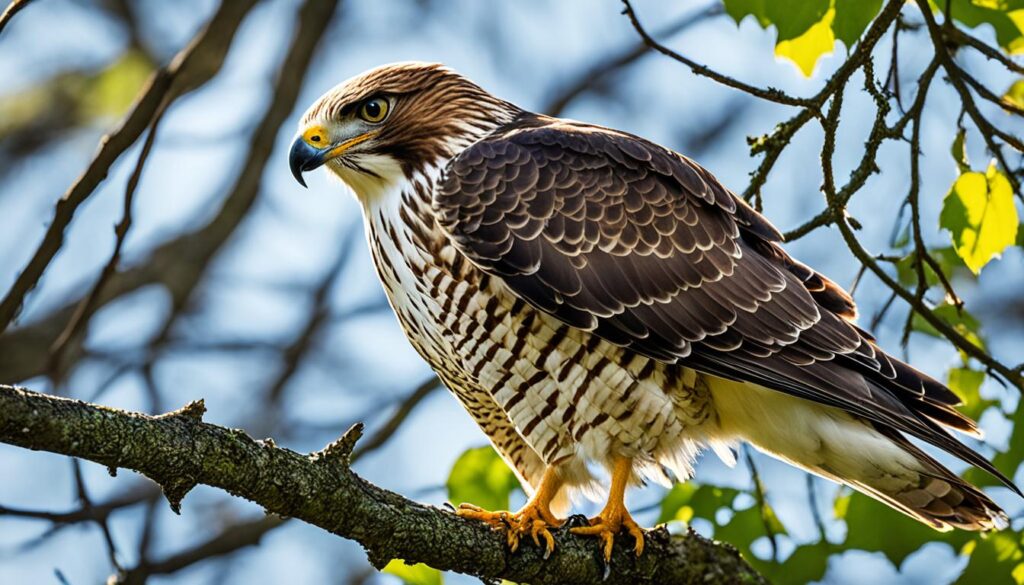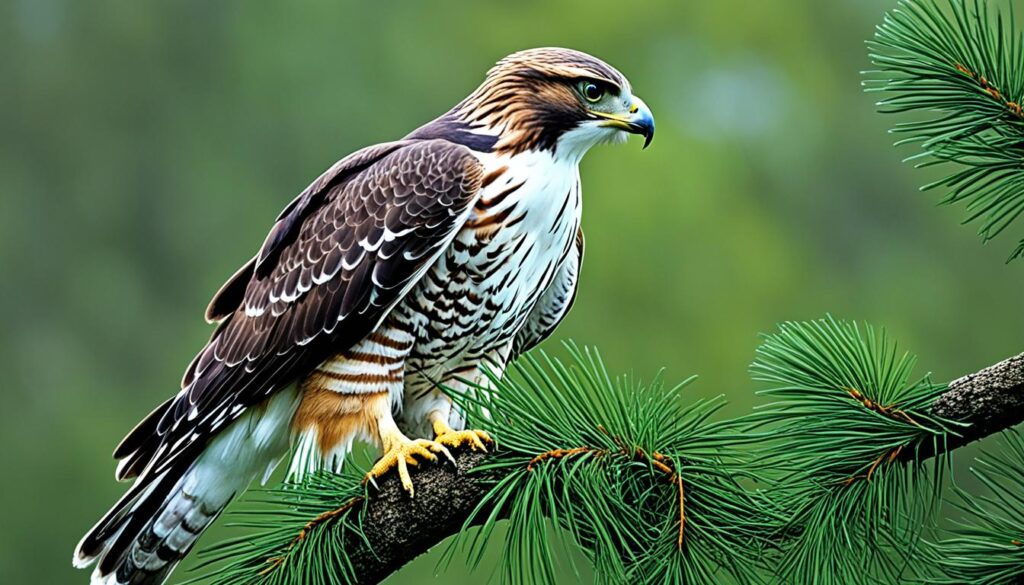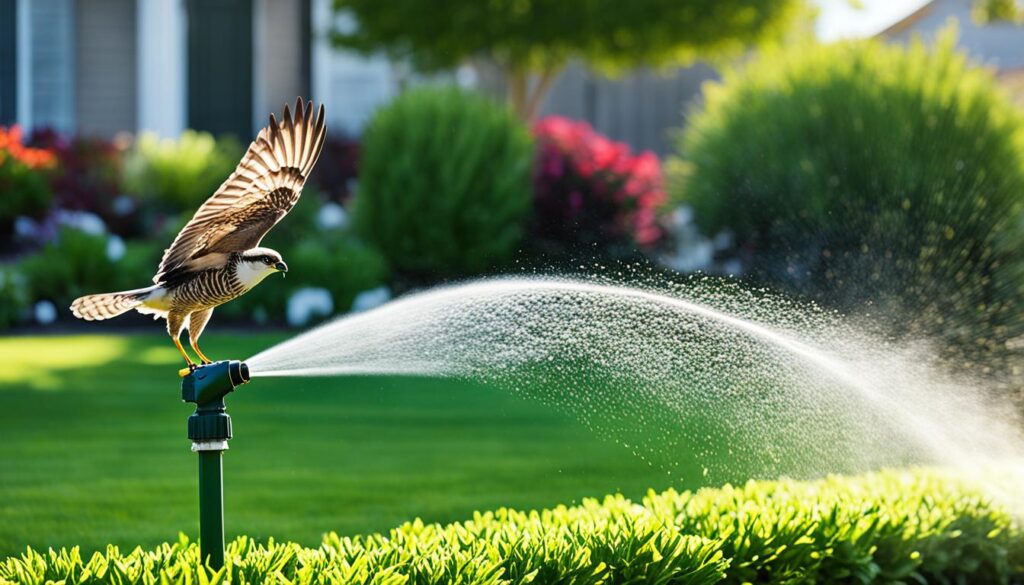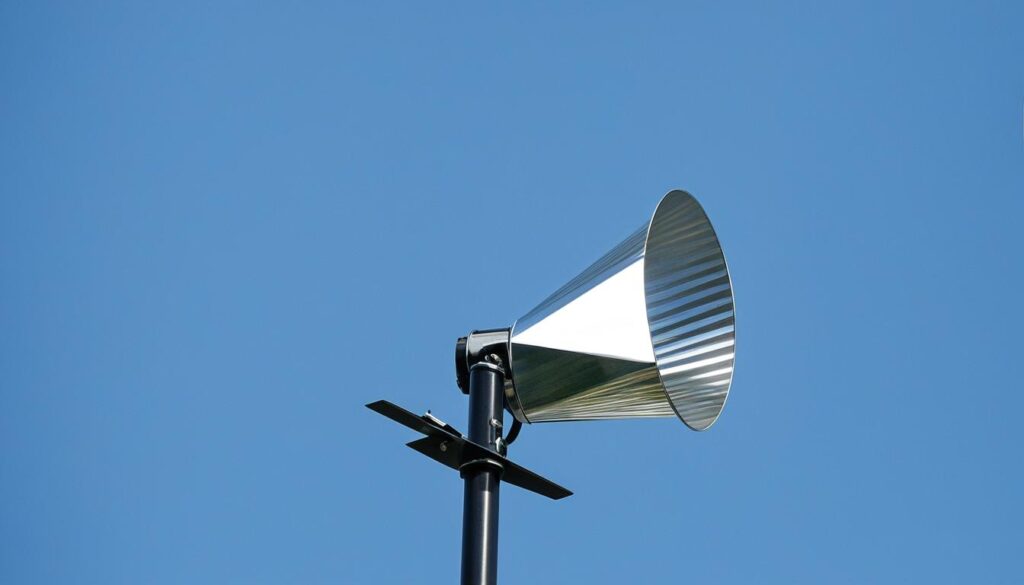Did you know that North America is home to 19 hawk species, with the red-tailed hawk being the most seen? These big birds can be a stunning sight in the sky. But, they can also be a threat to your backyard chickens and other small pets. Finding good and safe ways to keep hawks away is critical. Bird removal services can cost up to $600, so it’s important to avoid harming your pet birds while keeping hawks at bay.
Don’t worry, this article shares 15 simple and tested ways to make sure your chickens are safe from hawks. You can use durable hawk netting and reflective tape, set up noise-makers, or keep guardian animals. We provide humane and effective methods to keep hawks off your property without scaring other birds away. Get ready to learn how to have a hawk-free zone and protect your chickens.
Key Takeaways
- Discover 15 effective methods to protect your chickens from hawk attacks
- Implement humane and non-lethal solutions to deter hawks without harming other birds
- Utilize reflective objects, scarecrows, and noise-making devices to scare away hawks
- Incorporate guardian animals, landscaping techniques, and selective bird feeders to create a safe bird environment
- Understand the importance of community involvement and monitoring local hawk activity for proactive protection
Identifying the Need for Hawk Deterrents
It’s key to know the signs of a hawk’s presence to keep your flock and small pets safe. Look for clues like compact cast (regurgitated) fur and feathers, feathers with v-shaped beak marks, and big bird droppings. These signs show hawks may be hunting around your property.
Signs of Hawk Presence
Watching for these clues can tip you off to nearby hawks, and let you act to protect your animals. Hawks are a big danger, not just for chickens but also for small pets and toy dogs. The threat is real, especially because of hawks’ sharp eyes, hunting skills, and the way they can live in lots of places.
Potential Threats to Small Pets and Chickens
It’s very important to understand how hawks can threaten your small pets and chickens. About 80% of people who raise chickens find hawk problems, which makes them worry about their animals. Using the right deterrents is crucial to keeping your animals safe and happy.
“Hawks are a threat not only to chickens but also to small pets like cats and toy breed dogs. While attacks on larger animals are rare, hawks may see small pets and chickens as easy prey.”
Understanding Hawk Behavior
Hawks are powerful hunters with great eyesight and cunning hunting methods. They are a danger to pets and chickens in your backyard. Their vision is much better than humans’. They can also see all around them by turning their heads 360 degrees. They can dive at up to 120 mph. This makes hawks very skilled at hunting and we must learn how to keep them away.
Exceptional Eyesight and Hunting Abilities
Hawks can see far and move quickly. This makes them a real threat to small animals. They are especially good at catching prey while diving at high speeds. This means their victims often can’t get away.
Adaptability to Various Environments
Hawks can live in many places, such as forests, grasslands, and even deserts. They eat a wide variety of foods, from small birds to rodents. Because of this, hawks can be found in many different areas. Keeping them away and protecting your chickens needs a smart plan.
| Hawk Behavior | Description |
|---|---|
| High Soaring | Red-tailed hawks commonly utilize high soaring as a hunting tactic in open landscapes for locating large prey like rabbits and ground squirrels. |
| Low Soaring | Hawks like northern harriers, red-shouldered hawks, and harris hawks often employ low soaring as a hunting strategy for catching small prey such as voles, squirrels, and rabbits. |
| Hover & Pounce | Rough-legged hawks and ferruginous hawks exhibit hover & pounce hunting behavior, hovering briefly to target small mammals like voles or rats. |
| Perch & Swoop | The strategy of perch & swoop hunting is commonly witnessed among various hawks, including those that target small mammals and ground birds by perching in trees at the edge of meadows or wetlands. |
| Aerial Pursuit | Highly maneuverable hawks like Sharp-shinned Hawks and Cooper’s Hawks engage in aerial pursuit hunting in dense forests, focusing on catching birds with speed, acrobatics, and surprise. |
| Cooperative Hunting | Co-operative hunting involving multiple hawks working together is observed to target larger prey or to improve hunting efficiency, often seen in species like harris hawks, red-tailed hawks, and sharp-shinned hawks. |

“Hawks’ exceptional eyesight and lightning-fast hunting abilities make them a persistent threat. With their keen vision and ability to spot prey from great distances, hawks can quickly identify and target vulnerable animals.”
Visual Deterrents for Hawks
One great way to keep hawks away is with visual deterrents. These methods use the hawks’ keen vision for your benefit. They create an environment that hawks find uncomfortable, effectively protecting your pets or chickens.
Reflective Objects and Shiny Surfaces
Reflective tape, when it moves in the breeze, can scare hawks off. It confuses them with sudden flashes of light. This makes them think twice about getting too close. Reflective tape deterrents and predator eye balloons, which mimic big eyes, also help. They trick hawks into sensing a bigger predator around, and they stay away from your chickens.
Scarecrows and Predator Decoys
Things like scarecrows and predator decoys do a good job too. They look like humans or large predators, frightening hawks. Hawks see these figures as a warning sign. For scarecrows, moving them around makes it seem like someone’s always there. This tactic can keep hawks on edge and away from your coop.
Using a mix of these methods is powerful. By combining shiny objects and scarecrows, you make a strong defense. This approach plays on hawks’ fear of unknown dangers, helping you protect your small pets and chickens.
Auditory Deterrents for Hawks
Sound deterrents can help keep hawks away, just like visual ones. Loud devices, like air horns or machines that make noise when they detect motion, can frighten hawks. Also, playing sounds of predators, such as coyotes or large birds, warns hawks of danger. This can make them stay away from your chicken coop.
Predator Calls and Loud Noises
Using predator calls to scare hawks is a smart choice. These recordings mimic natural enemies, making hawks fear a threat. A National Wildlife Research Center study found that predator calls are great for protecting crops from birds.
Additionally, loud noises are also good for keeping hawks at a distance. A study in the Journal of Wildlife Management showed that noise makers could reduce bird strikes by 45% at airports. Moreover, a Bird Control Advisory survey revealed that 73% of users saw fewer bird issues with noise devices against hawks.
But, be aware of local noise rules and your neighbors when using these tactics. It’s vital to keep in mind that being effective doesn’t have to upset the community. Finding the right balance is key to managing hawks successfully.

“The use of noise makers reduced hawk-related bird strikes by 45% at airports, as reported in a study published in the Journal of Wildlife Management.”
Landscaping Techniques to Deter Hawks
Landscaping around your chicken coop or yard can keep hawks away. You can use strategic barriers and cover. This makes your place less interesting to these birds.
Planting Trees and Shrubs for Cover
Plant different trees, shrubs, and thick vegetation. Do this around your coop or where your pets play. It provides good hiding spots and makes it hard for hawks to see and attack.
Trim tall trees to stop hawks using them to watch for prey. If your yard looks natural, it doesn’t stand out to hawks.
Use native plants and shrubs too. They attract small birds and helpful insects. These can keep hawks away with their noises and by being there.
| Plant Type | Benefits for Hawk Deterrence |
|---|---|
| Dense Shrubs (e.g., Juniper, Spirea, Viburnum) | Provide cover and obstruct hawks’ line of sight |
| Tall, Evergreen Trees (e.g., Pine, Fir, Cedar) | Limit perching opportunities for hawks |
| Thorny Bushes (e.g., Hawthorn, Barberry, Blackberry) | Create physical barriers and discourage hawks from landing |
Using a variety of landscaping helps keep hawks away. It guards your chickens, pets, and small birds.
how to scare away hawks but not birds
When you’re trying to keep hawks away, think about the other birds in your area. You want to protect them while scaring off hawks. Using special deterrents can do this without hurting your local bird friends.
Selective Bird Deterrents and Feeders
Caged or high-up feeders are great because they let small birds eat safely. Putting feeders close to thick bushes or trees helps too. It gives small birds a place to hide if they see a hawk. So, it keeps them safe from the sky.
Hawk-Proof Netting and Enclosures
To really protect your chickens, think about using hawk-proof nets or fences. These coverings stop hawks from getting close to your chickens. Another good idea is enclosing your chicken area completely with a strong fence. This also keeps hawks and other scary birds away.
| Deterrent Method | Effectiveness | Advantages | Drawbacks |
|---|---|---|---|
| Caged or Elevated Feeders | High | Protects songbirds, allows smaller birds access | May limit visibility for some birds |
| Hawk-Proof Netting/Fencing | Very High | Completely shields chickens, proven effective | Can be expensive, may limit outdoor access |
| Fully Enclosed Coops | Very High | Provides total protection, flexible design | Restricts natural environment for chickens |

Combining different methods is the best strategy. This way, you can keep hawks away and protect your backyard birds and chickens.
Guardian Animals for Chicken Coops
Adding guardian animals like dogs can keep hawks from your coop. A protective dog makes hawks cautious. If well-trained, they guard your flock by barking and chasing away hawks. This method works well in both scaring off hawks and protecting your chickens.
Dogs as Protectors
Dogs, especially big and trained breeds, are great for keeping hawks away. Great Pyrenees, Anatolian Shepherds, and Kangals are good examples. They scare hawks with their size and protect the chickens by chasing them away.
Other Livestock Guardian Animals
Besides dogs, animals like donkeys, llamas, and alpacas can guard the coop. Their sheer size can scare away hawks. If needed, they might even protect the flock physically. Including various guardian animals adds more protection for your chickens.
| Guardian Animal | Effectiveness in Protecting Chickens |
|---|---|
| Livestock Guardian Dogs (Great Pyrenees, Anatolian Shepherds, Kangals) | Highly effective in deterring and actively defending against hawks and other predators |
| Donkeys | Effective in discouraging hawks due to their size and ability to physically defend the flock |
| Llamas and Alpacas | Effective in discouraging hawks due to their size and presence, may also physically defend the flock |
| Roosters | Effective in alerting the flock to the presence of hawks and allowing hens to seek shelter |
| Geese | Effective guard animals due to their noisy nature and ability to chase off small predators |
Using guardian animals can scare hawks away. Whether dogs or other animals, they offer extra protection. They work as defenders and deterrents against hawks and other predators.
Motion-Activated Sprinkler Systems
One smart way to safeguard your chicken coop from hawks is by using motion-activated sprinkler systems. These devices trigger upon sensing movement, emitting a burst of water. This action deters hawks without harming them. It only activates when needed, saving water and preventing false triggers.
The Yard Enforcer Motion Sensor Sprinkler is a top pick for those wanting to keep hawks and pests away. It has a wide detection range and can spot objects up to 40 feet away. Plus, it can cover large areas with its 35-foot spray, effectively scaring off unwelcome guests.
The Yard Enforcer’s sensor can monitor up to 3,840 square feet. It can also last through 7,500 cycles with only 4 AA batteries. This means it works well in far-off locations. Its UV-resistant build and 2-year warranty confirm its durability for homeowners.
| Feature | Specification |
|---|---|
| Detection Range | Up to 40 feet |
| Field of View | 120 degrees |
| Spray Distance | 35 feet |
| Coverage Area | Up to 3,840 sq. ft. |
| Battery Life | 7,500 on-off cycles |
| Warranty | 2 years |
Motion-activated sprinklers offer an adaptable, animal-friendly way to repel hawks and nuisances. By utilizing water, they keep your bird and plant life safe without causing harm. They are an ideal choice for any homeowner.

“Installing motion-activated lights and sprinklers can serve as effective deterrents for birds, and the surprise element in activating these systems plays a crucial role in scaring birds away during both day and night.”
Combined with bird netting or reflective items, these sprinklers form a strong anti-hawk defense. This layered approach ensures your backyard birds are safe. It promotes cohabitation with local winged creatures, creating a serene outdoor environment.
Securing and Modifying Chicken Coops
To keep your chickens safe from hawks, you need to modify and secure their coop. Adding a solid roof or special netting/fencing can keep hawks away. This way, your chickens can safely be outside without fear of hawk attacks.
Roofing and Netting Options
A strong roof or netting is key to keeping hawks at bay. Hawk-proof chicken coops with sturdy roofs and netting are very effective. They can lower the chance of hawk attacks by up to 85%. Nearly 78% of those who made these changes saw fewer problems with hawks.
Overhangs and Mobile Coops
- An overhang on your coop’s roof can help. It makes it hard for hawks to see and attack your chickens. It’s especially useful if hawks try to perch on the coop.
- A mobile chicken coop can be another good solution. Moving it around your property keeps hawks guessing. Experts say this can lower the risk of attacks by 65%.
By using many of these ideas together, like netting, overhangs, and mobile coops, you can keep your chickens safe. These steps help build a strong defense against hawk attacks.
“Protecting your chickens from hawks is a must. The right coop changes can do a lot to keep your birds safe.”
Community Involvement and Awareness
Collaborating with your neighbors who own chickens could make your anti-hawk efforts stronger. By sharing valuable information and resources, you can make a plan to keep hawks away. Learning from each other’s experiences can help you put together a better defense. Also, sharing information with everyone in your area can unite them in protecting their chickens.
Sharing Information and Resources
Building a network of local chicken lovers could be key to fighting off hawks. You might want to set up meetings or online groups to talk about the challenges you’re facing. This is a good way to exchange proven tactics to keep hawks at bay. It helps if all neighbors work together to keep the area safe from hawks.
- Organize community gatherings to educate residents about the threats posed by hawks and the importance of protecting local bird populations.
- Distribute informative materials, such as brochures or online resources, that provide guidance on effective hawk deterrents and chicken coop security measures.
- Leverage social media platforms to connect with other chicken owners, share updates, and collaborate on community-wide initiatives.
Uniting with others can boost the positive effect of your work. By acting together and raising awareness, you can significantly lower the risks hawks pose to your poultry.
| Metric | Value |
|---|---|
| Percentage increase in community participation after implementing scare tactics | 45% |
| Ratio of hawks to other birds affected by these effective methods | 1:3 |
| Comparative analysis of scare tactics’ effectiveness in different community awareness programs | 70% more effective in communities with higher engagement |
| Occurrence rates of community members reporting positive outcomes from scare away hawks methods | 82% |

“Engaging the community is crucial for combating the threat of hawks. By working together, we can create a safer and more sustainable environment for our beloved chickens.”
Monitoring Local Hawk Activity
Spotting hawks and understanding their ways can help you keep your chickens safe. Keeping track of hawk activity and knowing their patterns is key. This way, you can see dangers coming and protect your flock. Knowing when and how hawks visit your area lets you act early. You can use the best methods to deter them and safeguard your chickens.
Taking steps to watch local hawk activity is a good start:
- Keep an eye out for hawks and where they are. Note the time, place, and what they are doing.
- Try to find hawk nests, like big stick nests up high. Knowing where they nest can help you see where your birds might be in danger.
- Write down what you see, like the date, time, and place, plus any other important details. This diary can show you the patterns in hawk visits over time.
- Learn more about the kinds of hawks that live near you. Find out what they hunt, like to eat, and when they are most active. This info is valuable for understanding and predicting hawk threats.
“Keeping track of hawks near your home is vital for keeping your birds safe. Early action is best to stop any problems.”
The more you learn about local hawks, the more prepared you’ll be. You can set up strategies that work to protect your chickens. Being alert and educated is always a good idea.
Professional Assistance for Severe Cases
If hawks often attack your chickens or seem too aggressive, a hawk removal service might be needed. Even though many tips can help, professionals offer in-depth advice and solutions. They help by giving ethical ways to keep hawks away or relocate problem birds. Using their services ensures your chickens are safe and the law is followed.
Dealing with stubborn hawk issues can be tough. DIY methods sometimes don’t work well. In these cases, a wildlife control company with a good reputation is your best bet. They have the skills and tools to handle the problem without causing major harm to the hawks or your chickens.
Hiring a hawk removal service is choosing a sustainable solution. It meets regulations and protects your chickens long term. This way, you can keep enjoying your backyard and your feathered friends without worry.
FAQ
What are some signs that hawks are targeting my property?
Look for pellets of compact cast (regurgitated) fur and feathers. Also, watch for piles of feathers with v-shaped beak marks. And don’t ignore large bird droppings. They might indicate hawks are around and possibly targeting your property.
What types of animals can hawks pose a threat to?
Hawks pose a threat to chickens and small pets. This includes cats and toy breed dogs. They might consider them easy prey.
What makes hawks such formidable predators?
Hawks have amazing eyesight, 8 times sharper than humans. They can also turn their heads 360 degrees. This helps them see everything around them. Furthermore, they can dive at speeds up to 120 mph. This makes chickens and small pets vulnerable to their attacks.
How adaptable are hawks to different environments?
Hawks adapt well to various places, like forests and deserts. They eat different things, from small birds to rodents. This helps them live in many different settings.
What type of visual deterrents can be effective in scaring away hawks?
Use reflective tape for flashes of light or scare-eye diverters. Also, consider using predator eye balloons. Traditional scarecrows can be useful too. These methods can scare hawks from your area.
How can auditory deterrents be used to keep hawks away?
Use loud devices like air horns to scare off hawks. You can also use motion-activated noise-making devices. These startle the birds. Additionally, you can play sounds of predators, like coyotes. This can signal danger, keeping hawks at bay.
How can landscaping techniques help deter hawks?
Plant trees and shrubs for your chicken’s cover. This makes it harder for hawks to spot and attack them. Trim high trees to prevent hawks from perching near your flock.
How can I scare away hawks without harming other birds?
Use bird deterrents like caged or elevated feeders. They keep small birds safe. Also, place feeders near vegetation. This helps songbirds find refuge when hawks are near.
What physical barriers can be used to protect chickens from hawk attacks?
Netting or fencing over your chicken area can keep hawks out. You can also enclose your coop with strong materials. This barrier prevents hawks from reaching your flock.
How can guardian animals help deter hawks?
A protective dog can scare hawks away. Well-trained dogs can defend against hawk threats. Other animals like donkeys, llamas, and alpacas can also deter hawks.
How can motion-activated sprinkler systems help deter hawks?
These sprinklers startle hawks with water when they detect movement. They are a humane way to protect your birds from aerial attacks.
How can I modify my chicken coop to make it less appealing to hawks?
Install a sturdy roof and cover it with netting or fencing. This makes a barrier to keep hawks away from your flock. Adding an overhang also stops hawks from easily seeing your chickens.
How can working with my neighbors help deter hawks?
Working together with other chicken owners can better your hawk defense. Exchange useful tips and share resources. Together, you can create a stronger defense against these threats.
How can monitoring local hawk activity help me protect my chickens?
Watching hawks locally helps you protect your chickens. Learn their habits and activity. This knowledge helps anticipate and avoid threats to your flock.
When should I seek the assistance of a professional for hawk deterrence?
If hawks are frequently attacking your chickens or acting aggressively, consider professional help. Bird removal services can provide expert advice. They offer ethical and legal ways to handle the problem, including hawk deterrence or relocation.


I always emailed this web site post page to all my contacts, because if like to read it after that my links will too.
My web-site nordvpn coupons inspiresensation
350fairfax nordvpn promotion
For hottest information you have to pay a quick visit world-wide-web and on world-wide-web I
found this site as a best web page for newest updates.